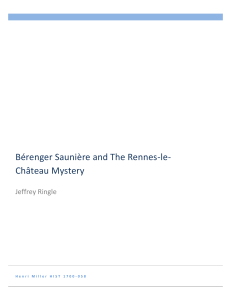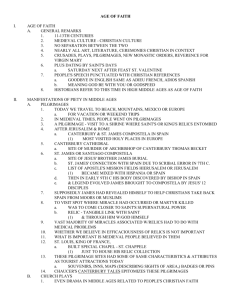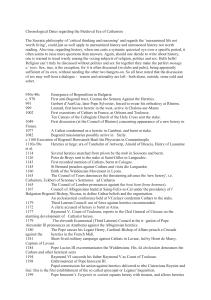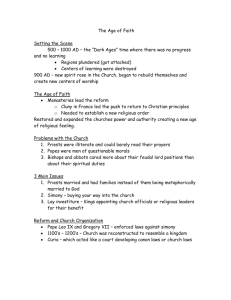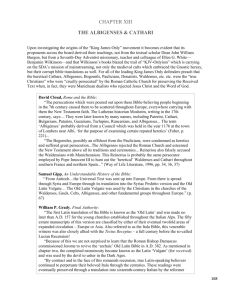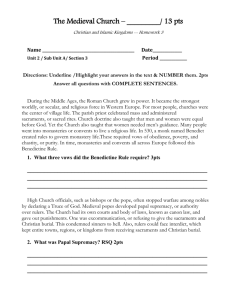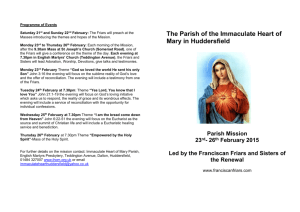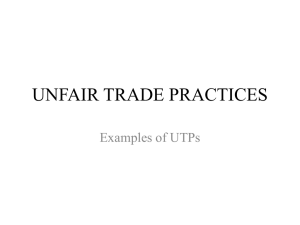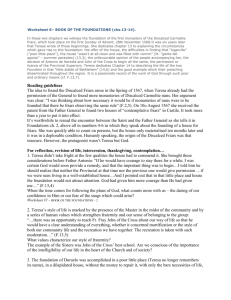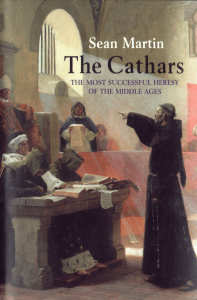The Waldnsians or Poor of Lyons
advertisement
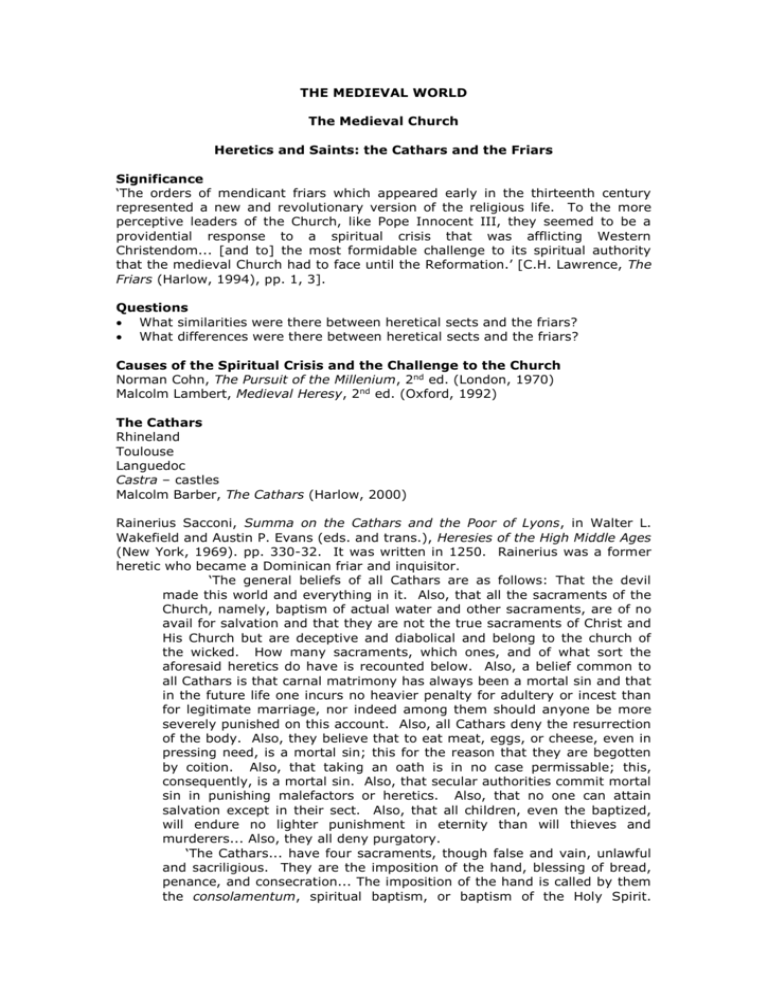
THE MEDIEVAL WORLD The Medieval Church Heretics and Saints: the Cathars and the Friars Significance ‘The orders of mendicant friars which appeared early in the thirteenth century represented a new and revolutionary version of the religious life. To the more perceptive leaders of the Church, like Pope Innocent III, they seemed to be a providential response to a spiritual crisis that was afflicting Western Christendom... [and to] the most formidable challenge to its spiritual authority that the medieval Church had to face until the Reformation.’ [C.H. Lawrence, The Friars (Harlow, 1994), pp. 1, 3]. Questions What similarities were there between heretical sects and the friars? What differences were there between heretical sects and the friars? Causes of the Spiritual Crisis and the Challenge to the Church Norman Cohn, The Pursuit of the Millenium, 2nd ed. (London, 1970) Malcolm Lambert, Medieval Heresy, 2nd ed. (Oxford, 1992) The Cathars Rhineland Toulouse Languedoc Castra – castles Malcolm Barber, The Cathars (Harlow, 2000) Rainerius Sacconi, Summa on the Cathars and the Poor of Lyons, in Walter L. Wakefield and Austin P. Evans (eds. and trans.), Heresies of the High Middle Ages (New York, 1969). pp. 330-32. It was written in 1250. Rainerius was a former heretic who became a Dominican friar and inquisitor. ‘The general beliefs of all Cathars are as follows: That the devil made this world and everything in it. Also, that all the sacraments of the Church, namely, baptism of actual water and other sacraments, are of no avail for salvation and that they are not the true sacraments of Christ and His Church but are deceptive and diabolical and belong to the church of the wicked. How many sacraments, which ones, and of what sort the aforesaid heretics do have is recounted below. Also, a belief common to all Cathars is that carnal matrimony has always been a mortal sin and that in the future life one incurs no heavier penalty for adultery or incest than for legitimate marriage, nor indeed among them should anyone be more severely punished on this account. Also, all Cathars deny the resurrection of the body. Also, they believe that to eat meat, eggs, or cheese, even in pressing need, is a mortal sin; this for the reason that they are begotten by coition. Also, that taking an oath is in no case permissable; this, consequently, is a mortal sin. Also, that secular authorities commit mortal sin in punishing malefactors or heretics. Also, that no one can attain salvation except in their sect. Also, that all children, even the baptized, will endure no lighter punishment in eternity than will thieves and murderers... Also, they all deny purgatory. ‘The Cathars... have four sacraments, though false and vain, unlawful and sacriligious. They are the imposition of the hand, blessing of bread, penance, and consecration... The imposition of the hand is called by them the consolamentum, spiritual baptism, or baptism of the Holy Spirit. 2 According to them, without it mortal sin is not forgiven, nor is the Holy Spirit imparted to anyone; both of these occur only when the rite is performed by them... no remission of sins is accomplished by that imposition of the hand if those who impose the hand are in any mortal sin at the time. This imposition of the hand is performed by at least two persons, and not only by their prelates but by those under them, even, in case of need, by Cathar women... The blessing of bread by the Cathars is a certain bread-breaking which they perform daily at the morning and evening meal. This breaking of bread is done thus: When the Cathars, men and women, have come to the table, they remain standing while they say the Lord’s Prayer... The penance of the Cathars is altogether false and vain, deceptive and poisonous... For in true penance three things are requisite: contrition of heart, confession of the lips, and satisfaction by works... not one of these three appears among the Cathars...’ Peter of Vaux-de-Cernay, History of the Albigensians, in Wakefield and Evans (eds. and trans.), Heresies of the Middle Ages, p. 239. It was written c. 1213. Peter was a Cistercian monk who took part in the Crusade against the Cathars in the Languedoc. Albi gens = the people of Albi, a town in the Languedoc. Albigensian is a name for the Cathars in this region. ‘...certain of the heretics were called the Perfect or the Good Men; the others were called the believers... Those who were called the Perfect wore a black mantle; they claimed that they kept themselves chaste; they wholly refused to eat meat, eggs, or cheese; they sought to give the impression of never telling a lie... and they held that one should never for any reason take an oath. Those who were called believers... while living in the world, did not strive to attain the life of the perfected, but hoped nonetheless to achive salvation in their faith... they believed that they would be saved... without confession and penance, so long as they were able in the last throes of death to repeat the Lord’s Prayer and receive the imposition of hands by their officials.’ Rainerius Sacconi, Summa on the Cathars and the Poor of Lyons, in Wakefield and Evans (eds. and trans.), Heresies of the Middle Ages, pp. 335-36: “The offices of the Cathars are four. He who has been established in the first and highest office is called bishop; in the second, the elder son; in the third, the younger son; and in the fourth and last, the deacon. The others among them, who are without office, are called Christian men and women. It is the duty of the bishop always to take the first place in everything they do, namely, in the imposition of the hand, the breaking of bread, and beginning the prayer. In the absence of the bishop, the elder son presides, and in the absence of the elder son, the younger son does so... All the offices above are conferred by the imposition of the hand...” Count Raymond VI of Toulouse Pope Innocent III: ‘Attack the followers of heresy more fearlessly even than the Saracens - since they are more evil - with a strong hand and a stretched out arm.’ [Quoted in Barber, The Cathars, p. 107] Simon de Montfort Montségur The Waldnsians or Poor of Lyons Waldes of Lyons 3 Bernardo Gui, The Conduct of the Inquisition of Heretical Depravity in Wakefield and Evans (eds. and trans.), Heresies of the High Middle Ages, pp. 388-404. This work was finished in 1323-24. Gui was a Dominican and one of the most important figures in the medieval Inquisition. He appears as a character in Umberto Eco’s bestselling novel, The Name of the Rose. “... the principal heresy of the aforesaid Waldenses was and still continues to be contempt of ecclesiastical authority... they hold and teach that every oath... has been forbidden by God as unlawful and sinful... [they claim] they have from God alone and from no other the power to hear confessions... they say that any righteous person... can perform the consecration of the body and blood of Christ, provided only that he be a member of their sect. This they apply even to women, with the same proviso that they belong to their sect. Thus they teach that every holy person is a priest.” St Francis of Assisi and the Order of Friars Minor (Franciscans) St Francis of Assisi (c.1181-1226) Primitive Rule Pope Innocent III Spoleto The Canticle of the Sun St Clare The second order: Poor Ladies of Poor Clares R.W Southern, Western Society and the Church in the Middle (Harmondsworth, 1970) Ages St Francis, The Rule of 1223: ‘I strictly command the friars, each and all, never under any circumstances to take money, whether it be in the form of coins or of gold, either directly themselves or through someone acting as an intermediary... The friars are to take nothing as their own, whether it be a house, or a place, or anything at all. Instead, they are to be as pilgrims and strangers in this world...’ [Ignatius Brady, O.F.M., (trans.), The Writings of St Francis of Assisi (Assisi, 1983), pp. 97, 98]. Conventual Franciscans Spiritual Franciscans St Dominic and the Order of Preachers (the Dominicans) St Dominic (c.1170-1221) Pope Honorius III Rule of St Augustine Bologna St Thomas Aquinas Inquisition
